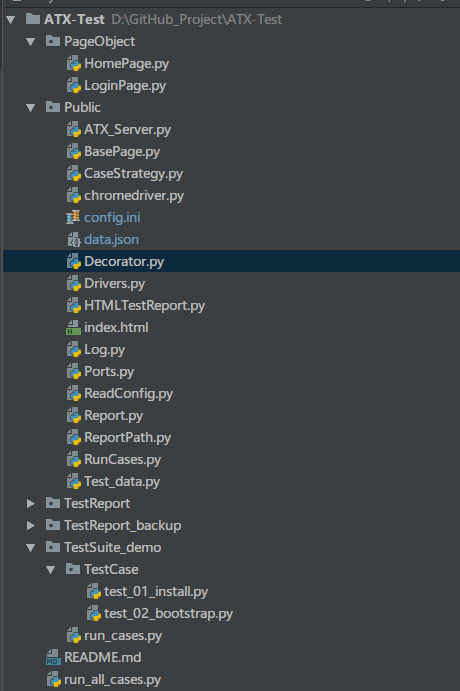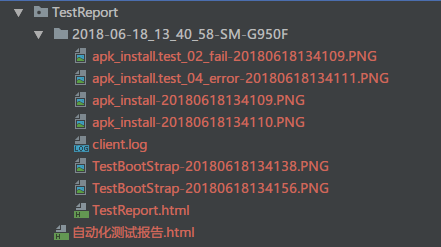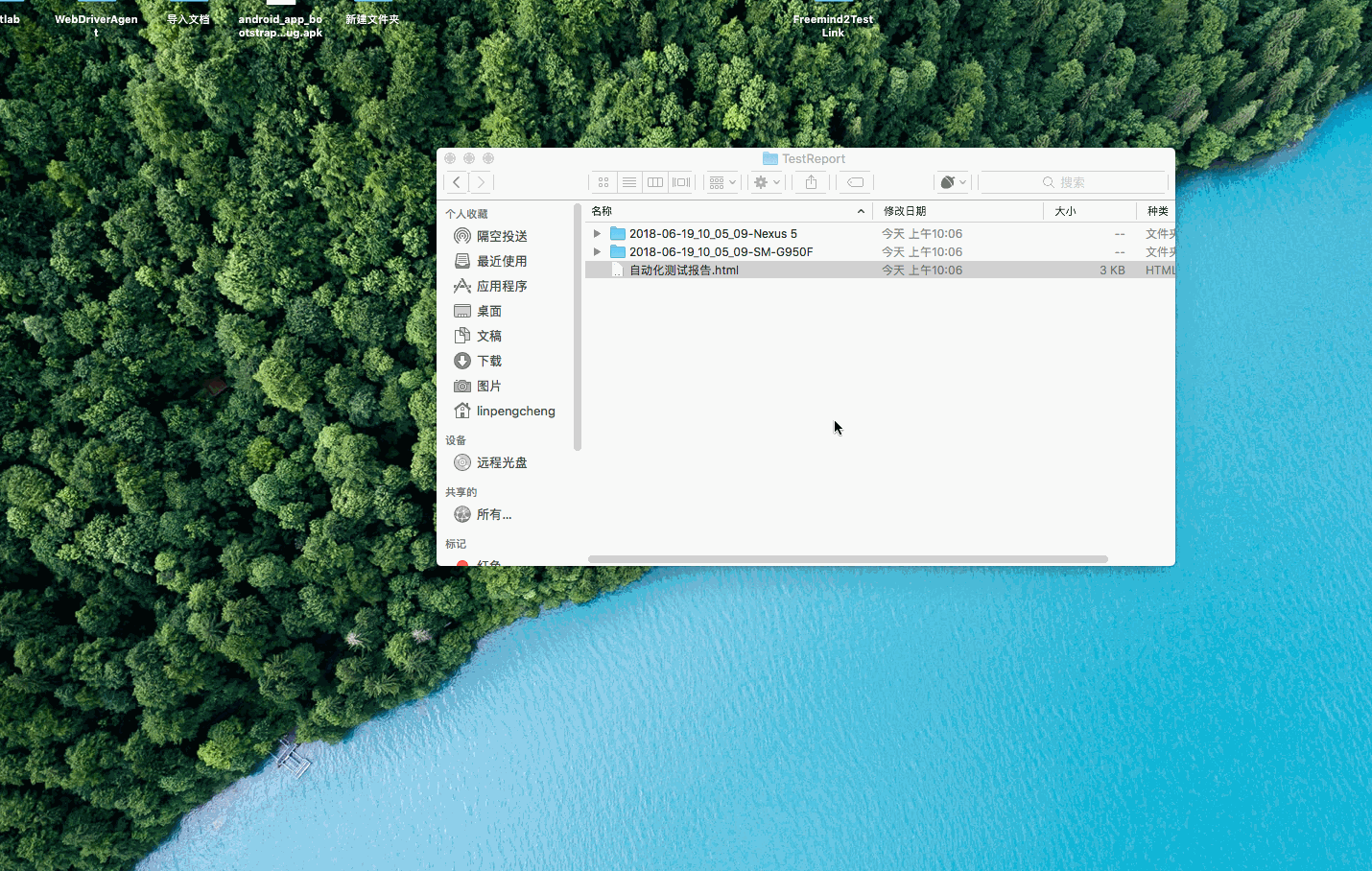基于ATX-Server的UI自动化测试框架,可以实现多设备的并行测试,并生成统一的测试报告
python2不支持 需要在python3上运行 本人python版本 3.6
Android设备需要通过uiautomator2 init 初始化完成,确认可以正常连接 ,或者init 接入atx-server uiautomator版本需 Version: 0.1.3.dev5 及以后
需要依赖的python第三方库 tinydb、uiautomator2、selenium、jinja2、psutil
相关的基础链接如下
小白入门篇:python uiautomator2 的代码示例
ATX-uiautomator2 实现 webview 的操作
1.下面展示的内容多源于TesterHome各位前辈的经验总结,我只是按照我的想法进行了简单拼接(基于ATX-uiautomator2的android自动化测试)
2.主要参考了hualin (王华林) 老师的https://testerhome.com/topics/7550 ,并在此基础上结合uiautomator2实现
3.所用语言为Python,测试报告模板借用了https://github.com/Gelomen/HTMLTestReportCN-ScreenShot ,并进行了简单的修改以方便截图
4.使用了macaca的bootstrap app作为demo演示
工程目录如下
主体结构和hualin (王华林) 老师的https://testerhome.com/topics/7550 的一致,主要修改了Pubilc下一些东西,并增加了一些东西
Public:
- Devices_new.py 获取atx-server上特定设备(get_online_devices())、或config.ini下devices IP列表的在线设备(get_devices())、有线连接电脑的设备自动连接u2(connect_devices())
- BasePage.py 用于设备的初始化 u2.connect 已经一些公共模块的封装
- chromedriver.py 和Ports.py 结合使用,启动chromedriver以便实现u2的webview操作(目前还没做到根据设备的chromeversion 启动指定版本的chromedriver)
- Casestrategy.py 获取指定路径下的testcases
- Decorator.py 有*@*testcase、*@*teststep这样的装饰器用例执行日志打印、错误后的处理(截图)
- Report.py 对生成的报告的一些操作,备份Testreport的报告到TestReport_backup下、多设备统一报告的生成、报告的文件夹压缩
- Test_data.py 在执行测试前的测试数据的生成,会在Plubic下生成data.json,测试执行的时候各个设设备更具自己的serial获取对应的测试数据
- Drivers.py 设备的获取,初始化准备,测试执行都是在这里完成的
- RunCases.py 存放测试报告/日志/截图的路径的生成,以及最终通过HTMLTestRunner来执行用例
- config.ini 一些需要用到的数据,atx-server地址、测试设备的ip、测试数据等
下面介绍一下流程:
1、通过run_cases .py或者run_all_cases.py开始执行测试
if __name__ == '__main__':
# back up old report dir 备份旧的测试报告文件夹到TestReport_backup下
backup_report()
cs = CaseStrategy()
cases = cs.collect_cases(suite=False)
Drivers().run(cases)
# Generate zip_report file 压缩测试报告文件
# zip_report() 1.首先会将Testreport目录剪切到TestReport_backup目录下,备份旧的测试报告
2.通过CaseStrategy获取到需要执的测试用例
3.Drivers().run(cases)开始执行测试
4.执行完成之后打包压缩,没啥用 注释掉了
2、run(cases)执行测试
def run(self, cases):
# 根据method 获取android设备
method = ReadConfig().get_method().strip()
if method == 'SERVER':
# get ATX-Server Online devices
# devices = ATX_Server(ReadConfig().get_server_url()).online_devices()
print('Checking available online devices from ATX-Server...')
devices = get_online_devices()
print('\nThere has %s online devices in ATX-Server' % len(devices))
elif method == 'IP':
# get devices from config devices list
print('Checking available IP devices from config... ')
devices = get_devices()
print('\nThere has %s devices alive in config IP list' % len(devices))
elif method == 'USB':
# get devices connected PC with USB
print('Checking available USB devices connected on PC... ')
devices = connect_devices()
print('\nThere has %s USB devices alive ' % len(devices))
else:
raise Exception('Config.ini method illegal:method =%s' % method)
if not devices:
print('There is no device found,test over.')
return
# generate test data data.json 准备测试数据
generate_test_data(devices)
print('Starting Run test >>>>>>>>>>>>>>>>>>>>>>>>>>>>>>>>>>>>>>')
runs = []
for i in range(len(devices)):
runs.append(RunCases(devices[i]))
# run on every device 开始执行测试
pool = Pool(processes=len(runs))
for run in runs:
pool.apply_async(self._run_cases,
args=(run, cases,))
print('Waiting for all runs done........ ')
pool.close()
pool.join()
print('All runs done........ ')
ChromeDriver.kill()
# Generate statistics report 生成统计测试报告 将所有设备的报告在一个HTML中展示
create_statistics_report(runs) 1.首先根据config.ini中method的值来判断从atx-serve获取online的设备 还是从config.ini中的ip来获取在线的设备
2.在获取到设备之后,根据设备生产data.json测试数据
3.并行多设备执行测试
4.测试完之后,杀掉执行过程中打开的所有的chromedriver进程
5.最后在TestReport下生成统计测试报告(自动化测试报告.html)
生成的测试报告路径结构如下
每个设备的测试结果及报告或存放在单独的文件夹下
在Testreport目录下会有一个统计测试报告(自动化测试报告.html)会将所有设备的报告统一在一个页面展示
报告展示:


